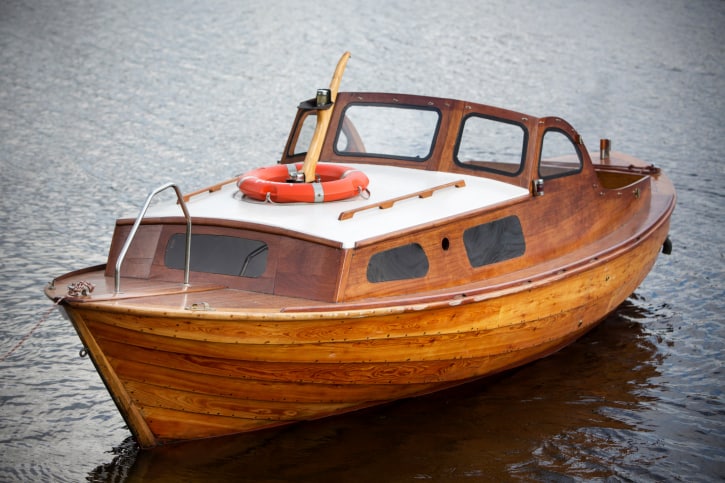By now, many of you have probably read about teak’s incredible potential as an investment, as well as of its many uses. If you have been on a boat, chances are you have been in contact with teak. From the wood runners along the sides to accents, even complete boat decks, teak has long been the most desirable wood for use in nautical applications. Any boat owner will tell you that it is absolutely the only wood that they would have on their boat.
While careful owners will attempt to keep the teak polished and looking like the day it was installed, oftentimes one will see teak that has been stripped of its polish and exhibiting a silver-grey color. While teak has a beautiful brown color when first processed and installed, that silver-grey color is actually desired by some. It shows off the durability and genuine nature of that teak. But that leaves the question, how could an unfinished, greying wood be so desirable? Don’t they need to replace it? The answer actually lies with the tree’s humble beginnings.
How Does It Start?
When first sprouting and starting its life, teak is vulnerable to the elements like any other plant. However, after just a few years, the teak wood begins to secrete a unique oil to protect it from the elements. The oil eventually saturates the wood of the teak tree, protecting it from infestation, rot, fungus, and even fire! That is one of the main qualities that make teak such an excellent choice for a timber investment. It naturally protects itself from many of the threats that can affect even the healthiest trees of other species. Not surprisingly, then, this oil also has benefits that last long after the life of the tree.
What Makes Teak So Special?
Those who process teak wood, though it is not an especially thick-grained wood, report that it is hard to work, and also emits an odd, distinct smell when cut and processed. This is all a result of the oil secreted by the wood, which increases in quantity over the lifetime of the tree. The wood, even after being cut, retains many of the benefits imparted to it by its oil. It remains impervious to water, and almost completely immune to rot. Those qualities are what make it ideal for applications that will often be exposed to the elements, such as boat decks and outdoor furnishings. In many applications and industries, wood has been replaced with metals, plastics, and other composites. Fortunately for owners of teak farms, that is not the case with teak wood.
Where is it used?
Partly due to aesthetics, and partly due to teak’s unique physical qualities, the wood has remained a staple in the boating industry, as well as the most sought-after material for outdoor furniture. Think about it. You’ve just installed a beautiful new deck on your dream house, and need furniture for it. Are you really going to buy those plastic Adirondack chairs from Home Depot? It’s only a matter of time before they crack through anyway. Metal slatted chairs that need cushions? One unexpected rain while you’re at the store and it’s off to buy new cushions. With teak, you have comfortable, luxurious-looking furniture that will last years, even generations. Unlike other “woods” often used in outdoor applications, this is not due to a coat of plastic encasing a laminate. It’s due to the same oil that kept the teak tree alive long enough to harvest in the first place.
How are you going to replace that look and feel of beautiful, genuine hardwood that has been a staple of good design for centuries? In short, it just won’t happen, and teak has been the wood of choice for thousands of years. One of the most expensive, in-demand woods in the world, teak continues to be imported and exported in massive quantities to keep up with ever-increasing demand. As countries like China and India not only grow in population but also in industrialization, teak’s demand will continue to increase. Unfortunately, most of the world’s natural teak forests were harvested, often illegally, with no thought of replanting. And though the valuable oil secreted by the wood is irreplaceable, luckily for investors, the teak forests of old are not. More and more teak is coming from private plantations in Central America, due to the region’s incentives for planting such farms, as well as the ideal climate for growth.
Conclusion
Now that you know what is so special about teak wood, look around the sides of the next boat you’re on. I bet you can impress your boat-owning friend with some teak trivia, and see how much they really know about the wood that’s been holding boats together for centuries. If you’re remodelling and need some outdoor furniture, look into teak options. Or, if you want to share the wonderfully unique wood with others, you can invest in the rapidly growing private plantation market. Those who invested nearly 20 years ago are nearing harvest, but it’s not too late to get in on a newly planted plantation. As you can see, the world is never going to stop needing teak. So armed with the knowledge of what makes this tree so unique, take the rare opportunity to join the supply-end of this age-old, valuable timber market.
For a really great read on all things teak, make sure to read: The Ultimate Guide To Investing In Teak Wood
In-demand, yet of dwindling supply in the marketplace, Teak is a remarkably valuable hardwood that is extremely durable, practical, and beautiful. To learn more about this opportunity please watch this special presentation by Rachel Jensen and Mikkel Thorup.
Like Our Articles?
Then make sure to check out our Bookstore... we have titles packed full of premium offshore intel. Instant Download - Print off for your private library before the government demands we take these down!






